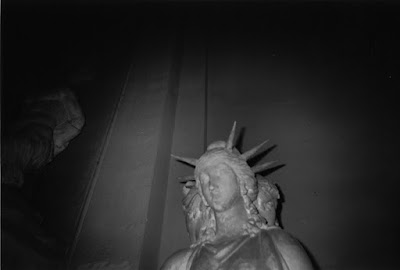AUGUST 12 – SEPTEMBER 13, 2015
Photographs by Arthur Bruso
Arthur Bruso has captured, in the photographs of Penumbra, that particular moment when we enter a dark room and strain to see. The images are almost completely black. A sense of place is occasionally suggested with a classical sculpture that seems to glow, or a clerestory revealed with a spot of light. The darkness feels solitary, populated only by an occasional marble figure. If anyone were to appear it would be a shock—unexpected in the moment you’re still gaining your bearings.
Once we’ve added up the hints, we can ascertain that the places visited here are the streets and cathedrals of Rome. Absent, other than the details, is sentimentality. When confronted with the everyday marvels of Rome it’s easy to work purely in service of the romance of the place. To either focus on its grandeur or charm. When a subject has been photographed so relentlessly it’s a challenge not to fall prey to conventions. Bruso reignites the possibility that there are still discoveries to make.
The images sometimes appear haphazard, as if we’re glancing around trying to locate an identifiable detail. This quality gives immediacy to the works, they’re in the process of disclosure. The prints themselves are beautifully produced. The blacks have a matte charcoal-like richness. The texture complements the idea that we’re feeling our way along in these cool, silent, echoing spaces. —Raymond E. Mingst
A Few Questions for Arthur Bruso
REM: You have a vast catalogue of photographs. You’ve printed hundreds and hundreds of images— these images span almost your entire life. You even have the first images you took with the first camera you received at 6 years old. Something we’ve talked about is how all of these photos are in play in your art practice. For example, in any given show we may be looking at an image you took as a very young person or an image you may have taken just last week. Confounding documentary considerations, like time and place, is a constant in your work. With that, how would you say your imagery has evolved over time?
AB: I’ve gotten better at using a camera. I believe that each camera “sees” differently. I have become more adept at exploiting those differences and using them to advantage in my work. I have also become less and less interested in the figure – I still have figurative work in my backlog, but in my newer work, I find I am more drawn to the landscape or inanimate objects. When I was younger (in college until after graduate school) I had the notion that I would be a Photographer who would make a Difference and a lot of my work was social commentary. These days, I find I am more interested in more esoteric ideas.
REM: For me, looking through the many boxes of your prints and shaping a show is a fascinating process. Identifying a theme or unifying element, selecting particular works and then writing about it, I feel a sense of authorship. However, it’s a collaborative process. Can you speak to what the process is like for you?
AB: A photographer can amass a large body of work in a short time, even when they are like me and are constantly editing – I never print every frame of film I expose. The curator can help make sense of the boxes of prints. I have my own ideas of what I want, but a curator shapes an exhibition which needs a cohesiveness that I may not have in my date defined boxes. Collaborating can be interesting in that way because I get to see my work through outside eyes. It can be frustrating as well, when there is a reinterpretation of the work that was never intended, but in the end, it becomes a back and forth, give and take. The curators I work with only want to show my work in its best light and for that I need to trust them.
REM: While you often talk about the aspects of your photos that aren’t documentary — composition, anomalies of the process that appeal to you, etc. — is nostalgia ever activated for you? Do you think about the when and where and what was going on in your life at the time you took the photo? Does your personal biography ever influence how you use your catalogue of images?
AB: Nostalgia is often a part of the work. I can remember the circumstances and my motivations for taking my first photographs. The image itself is often a trigger for me, and much of my work is about my experiences in a conceptual way.
REM: Can you speak more about that? How your work is about your experiences in a conceptual way…
AB: I don’t consciously plan to document my experiences in my work, but when I review it after it is complete I often see the connection. If you read the essays in my photo books, you will find that the photographic series relate to events in my life. The work may not actually portray what I discuss in the essay, but the essence is there.
REM: I referred to your “catalogue of images”. Is that how you would refer to them? Also, you keep each image in a plastic sleeve and those are kept in grey, archival storage boxes. Do you have a catalogue system so you can find particular images?
AB: I would call it a body of work. The organization is an evolving thing. My negatives I am bringing under control – or at least I have a system for them. My prints are more haphazard right now, but I am working on that.



No comments:
Post a Comment